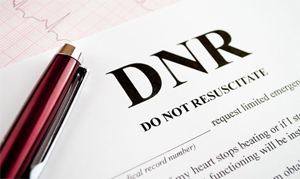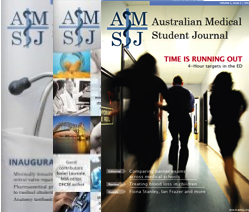Third Year Medicine (Undergraduate)
Australian National University

A 76 year old man with metastatic liver cancer lies feebly in his hospital bed surrounded by family. He’s in cardiac and respiratory failure. Attached to him are multiple lines, cannulas and monitors. There are more machines present than people. Despite this, his breathing is laboured, he’s gaunt, and he is clearly suffering. In a rare moment of lucidity, he gestures for his son to come closer and whispers: “No more.” An obviously grief stricken man turns to the rest of the family, gestures, and heads outside to make one of the most difficult decisions he will ever make.
Confused and anxious, a fifteen year old boy sits and listens to the pros and cons of stopping his grandfather’s treatment being discussed by the doctors and the family. Questions keep popping up in his head “Why is he giving up? How could they consider withdrawing treatment, the same treatment that was obviously keeping this man alive? How could anyone live with that decision?”
How do I know this? Because I was that fifteen year old boy.
It is, perhaps, ironic that modern advances in medicine have made it feasible to sustain life and sometimes suffering, for an indefinite period. [1] The dramatic improvement in technology for life preservation has created ambiguity and has dehumanised the dying process. The result of this is that very difficult legal and moral decisions must now be made about transitions from aggressive treatment to palliative care. [2] At times, the existence of this technology creates a moral obligation to use it, especially when societal belief is that to treat is to care. [3]
It was all too much back then for a teenage boy, but now ten years down the line, is it still too much for a medical student? After all, what can we as mere fledgling trainees do to help ease those heavy burdens? Reflecting on these experiences helps address the powerlessness we experience in these morally and ethically challenging cases and serves as a reminder to everyone that even as mere ‘students’, we are capable of playing a vital therapeutic role in the care of patients whose treatments have been deemed futile.
Defining futility
Looking back at that period of time now, it is difficult to justify the last few weeks of futile treatment that my grandfather received.
How does one decide when treatment is futile? Some have defined it quantitatively as treatments that have less than a 10% chance of success, [4] while others have tried to express it qualitatively as “treatment which provides no chance of meaningful prolongation of survival or may only briefly delay the inevitable death of the patient.” [5] The majority of physicians will deem this poor outcome unsatisfactory and thus the treatment futile; however, most families will not. [6] Whatever the definition, futile treatment is not a black and white concept, but must be considered as a complex composite of quality of life issues that need to be discussed either with the patient early in their diagnosis, or with their legal next of kin. [5]
Ethical decisions
This choice is difficult enough for clinicians with years of health-care experience, let alone medically untrained families under stress, grieving for the imminent loss of a loved one.
How are these decisions made? There are no protocols or parameters set out which suggest treatment should be withdrawn. While students are often taught to use the four principles of bioethics: beneficience, non-maleficience, autonomy and justice to guide them through ethically challenging cases, [7] the general public often places a special emphasis on beneficence, and thus consider continuing treatment as the only option. This was demonstrated in a questionnaire study by Rydvall and Lynoe (2008), asking both physicians and the general public when they believed treatments should be withdrawn from terminally ill patients. While the majority of physicians chose to withdraw treatment early on to prevent further suffering, the majority of the general public chose to continue aggressive treatment until the very end, stating that the first task of health care professionals is to save lives. [8]
This highlights the higher expectations that the general public may have of what the health care system should achieve, [8] which can lead to points of contention and miscommunication when it comes to making critical care decisions. The role of the medical student in these cases is often as a moderator; to listen, discuss and bridge the gap of communication between the two understandably apprehensive parties.
The therapeutic use of self
The feeling of helplessness was overwhelming, none of the doctors paid me any attention; I was just a child after all, not worthy of their attention or time. But he was my grandfather, not just their patient.
The concept of ‘therapeutic use of self’ is the use of oneself as a therapeutic agent by integrating and empathising with the patient and their family. This can be to alleviate fear or anxiety, provide reassurance and obtain or provide necessary information in an attempt to relieve suffering. [9] This is particularly relevant in circumstances where treatments have a limited effect on the disease process, where suffering is prolonged rather than prevented.
Medical school does not always formally teach the importance of connecting with patients and the therapeutic role that students play. [10] Many young aspiring doctors seek to emulate the ‘professional’ and sometimes detached demeanour of their more senior counterparts; often getting too close to the patients is seen to be a one way street towards emotional burnout. However, therapeutically, the importance of being physically near patients and their families during their personal illness and distress cannot be over stated. [9]
While many students may claim to never have enough time in their schedules, they are often the most time-rich personnel. For this reason they are often the only ones who have the opportunity to sit down with the family and the patient. This is not to take away, explain or understand the pain, but rather as a symbol of support, so that they know we are witnesses to their suffering and that they have not been abandoned. [10]
Withdrawing versus withholding
The debate went on throughout the night: “We’re abandoning him?”
“No, it’s for the best, he doesn’t need to go through any more of this, the doctor said there’s no way he’s going to get better.”
“You want to stop all treatments? We should be trying new things not stopping old treatments!”
Traditional medical training places an emphasis on the acquisition of skills and expertise to help ‘fix’ the patients or their diseases. Interestingly, many clinicians are more comfortable withholding treatment – that is, not beginning new aggressive treatments – than stopping currently initiated treatments. [1,11,12] This may be because withdrawing attaches a feeling of responsibility and culpability for the death. [3,13] To avoid this, clinicians will often only withdraw support when it becomes clear that death will occur regardless of further treatment. In this way, a “causative link between non-treatment and death is avoided.” [14]
Increasingly in today’s medical system, a simple ‘fix’ does not exist for many patients and their diseases. For these patients, success is judged not on the amelioration of the pathological process, but instead, on whether a good quality of life can be achieved in spite of the presence of chronic disease. Various religions and cultures have differing views on quality of life arguments adding a further layer of complexity to the decision making process. Therefore it is important to take the background of the patient and their relatives into consideration. [3]
Similarly, individual variations exist between physicians, because although each will use the most current evidence available to decide plans for the best outcome, each person is influenced by their own ethical, social, moral and religious views. [3] This perhaps, is the reason why the modern curriculum has incorporated elements of personal reflection, professionalism and social foundations of medicine to guide students into thinking more reflectively and sensitively, allowing for a more holistic patient-centered approach.
Moral decisions
“He’s not going to get better,” I was told, “The doctors said we should stop the treatments because all they’re doing is causing him to suffer.” Even I could understand that decision when it was justified to me like that. Unfortunately others don’t necessarily see it that way.
Moral situations often arise when clinicians tell relatives that they believe treatment will not help the patient recover, and the option is given to withdraw aggressive treatment in favour of palliative care. Many perceive continued treatment to not only be life sustaining, but also potentially curative, and thus moving onto palliative care is often interpreted as a choice to end their loved one’s life. [5] Some feel it is better to watch their relative die while undergoing treatment rather than live with the belief that they consented to death. [3, 5] Unsurprisingly, relatives will often demand that “everything be done” to preserve life. [5, 15, 16]
It is important to remind family that withdrawing futile treatment does not mean withdrawing all treatment. Palliative management including analgesia, respect for dignity, and support will always be provided throughout the ordeal. [2] We must be mindful that in this day of medical advancements, it is quite common that caring for a chronically ill loved one becomes the sole purpose in the carer’s life. The health care system has generated a ‘patient support system’ in which the carer has one role, and is deprived of energy and time for anything else, forgoing careers, friends and hobbies. It is perhaps unsurprising, that towards the end of a patient’s life, the carer maybe unwilling to let go of the only remaining source of meaning in their life. [6]
These difficult decisions often don’t need to be made if adequate preparation has been made beforehand, by having advanced care directives documented and a durable power of attorney arranged before the condition of the patient declines. These items can make a world of difference for both the family and the health care staff. [13]
Final thoughts
Would I have done anything differently if I had the maturity and the training that I have now?
Medical students in general feel that completing a full history and examination is the extent of what they can offer to patients; [16] however, this is often not the case. Their support and knowledge base is invaluable to patients and their family. Students play a vital therapeutic role in assisting the patient and family to come to terms with the limitations of modern medicine, and to recognise that extension of the dying process undermines what both the medical team and the family ultimately want – a dignified and peaceful death.
It is easy to objectively look at a patient with whom we’ve had no past relationship and decide what the right choice is. But for families, it will never be that straight forward when a decision has to be made about a loved one. During these times, as medical students, we need more than the ability to communicate effectively, we need the mental fortitude to be able to step into that dark and difficult place with the patient and their family to truly connect, and be there for them not only with our book smarts, but as figures of support and strength.
Never underestimate the therapeutic potential of who we are. While we may lack the mountains of factual knowledge of our senior colleagues, we have the potential to excel in the more humanistic aspects of patient care. By learning to approach these cases with compassion and humility, we can hope that our presence and understanding will render healing in situations that cannot be cured by our medical knowledge. [10]
As he requested, treatment was withdrawn and palliative care started, the 76 year old grandfather, father, and husband returned home and passed away in a dignified and peaceful way surrounded by family.
Acknowledgements
The author would like to thank his grandfather who gave him the world by teaching him to how to learn.
The author would also like to acknowledge the fantastic feedback provided by both reviewers which allowed him to gain a greater understanding into this fascinating topic.
Conflict of interest
None declared.
Correspondence
M Li: michael.li@anu.edu.au
References
[1] Slomka J. The negotiation of death: clinical decision making at the end of life. Soc Sci Med. 1992; 35(3): 251-9.
[2] Kasman DL. When is medical treatment futile? A guide for students, residents, and physicians. J Gen Intern Med. 2004; 19(10): 1053-6.
[3] Reynolds S, Cooper AB, McKneally M. Withdrawing life-sustaining treatment: ethical considerations. Surg Clin North Am. 2007; 87(4): 919-36, viii.
[4] Howard DS, Pawlik TM. Withdrawing medically futile treatment. J Oncol Pract. 2009; 5(4): 193-5.
[5] Murphy BF. What has happened to clinical leadership in futile care discussions? Medical Journal of Australia. 2008; 188(7): 418-9.
[6] Hardwig J. Families and futility: forestalling demands for futile treatment. J Clin Ethics. 2005; 16(4): 335-44.
[7] Beauchamp TL, Childress JF. Principles of biomedical ethics. New York: Oxford University Press; 1994.
[8] Rydvall A, Lynoe N. Withholding and withdrawing life-sustaining treatment: a comparative study of the ethical reasoning of physicians and the general public. Crit Care. 2008; 12(1): R13.
[9] Bartholomai S. Therapeutic Use of Self/Building a Therapeutic Alliance. In: Hospital I, editor.; 2008.
[10] Kearsley JH. Therapeutic Use of Self and the Relief of Suffering. CancerForum. 2010; 34(2).
[11] Pawlik TM, Curley SA. Ethical issues in surgical palliative care: am I killing the patient by “letting him go”? Surg Clin North Am. 2005; 85(2): 273-86, vii.
[12] Iserson KV. Withholding and withdrawing medical treatment: an emergency medicine perspective. Ann Emerg Med. 1996; 28(1): 51-4.
[13] Scanlon C. Ethical concerns in end-of-life care. Am J Nurs. 2003; 103(1): 48-55; quiz 6.
[14] Seymour JE. Negotiating natural death in intensive care. Soc Sci Med. 2000; 51(8): 1241-52.
[15] Foster LW, McLellan LJ. Translating Psychosocial Insight into Ethical Discussions Supportive of Families in End-of-Life Decision Making. Social Work in Helath Care. 2002; 35(3): 37-51.
[16] Frank J. Refusal: deciding to pull the tube. J Am Board Fam Med. 2010; 23(5): 671-3.
 Download PDF
Download PDF Read online
Read online You can subscribe by e-mail to receive each issue when it's published.
You can subscribe by e-mail to receive each issue when it's published.
 Download the issue
Download the issue Print this extract
Print this extract Share on Facebook
Share on Facebook


